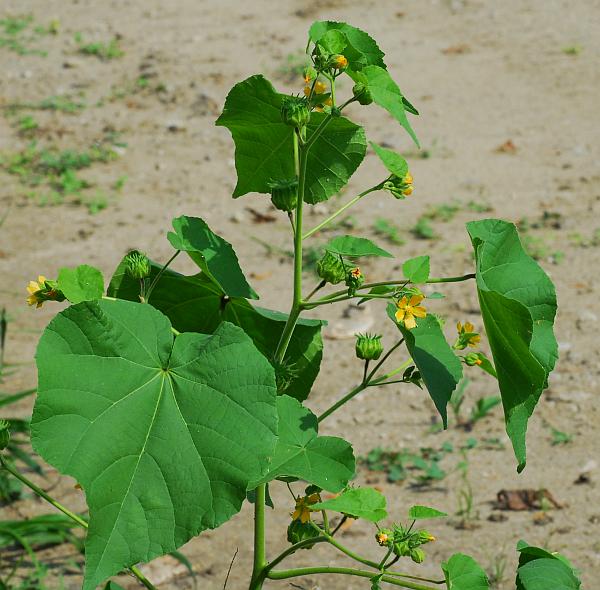Abutilon theophrasti Medik.
Velvet-Leaf

Introduced
CC = *
CW = 3
MOC = 50
© SRTurner
Abutilon theophrasti Medik.Velvet-Leaf | |
 |
Introduced CC = * CW = 3 MOC = 50 |
© SRTurner |
|
Family - Malvaceae Habit - Taprooted annual forb.
Stems - Ascending to erect, to 2 m, branched or not, densely pubescent with stellate hairs.
Leaves - Alternate, simple, long petiolate. Blades to 20 cm long, heart shaped, strongly cordate at the base, abruptly long-tapered at the tip, the margins entire or shallowly toothed, densely pubescent with stellate hairs. Surfaces soft and velvety to the touch. Stipules 3-8 mm long, linear, shed early.
Inflorescences - Flowers solitary in leaf axils, or in loose terminal and axillary clusters. Bractlets absent. Flowers - Calyces 5-12 mm long, cup-shaped or becoming reflexed at fruiting, the sepals free nearly to the base, the lobes ovate. Petals 6-15 mm long, the tips truncate or more commonly shallowly notched, yellow to orange-yellow. Stamens numerous, the staminal column circular in cross-section, the anthers yellow. Pistils with 9-15 locules, the carpels arranged in a loose apically flattened ring. Styles fused most of their length, each branch with a globose terminal stigma.
Fruits - Schizocarps, splitting into 9-15 mericarps. Mericarps 10-18 mm long, wedge-shaped, becoming blackened at maturity, with a prominent beak, oblong to kidney-shaped in profile, dehiscing apically from the center to the beak at maturity, 3-9-seeded. Seeds 3-4 mm long, kidney-shaped to nearly triangular, the surfaces minutely stellate-hairy, black.
Flowering - June - October. Habitat - Crop fields, waste ground, disturbed sites, roadsides, railroads. Origin - Native to India. Lookalikes - None. Other info. - This plant can be found throughout Missouri, and also occurs in many parts of the continental U.S., particularly the upper Midwest. It was originally introduced in the U.S. in the early 1800s as a fiber source for cordage, and has since become one of the most important broadleaf weeds of crop fields in the U.S. In fact, the Syngenta corporation in North Carolina has researched varieties of corn which produce an herbicide specifically targeted against Abutilon. The plant is most commonly seen along disturbed roadsides and in unkempt cultivated fields, and rarely anywhere else. It is easy to identify as nothing else in the state much resembles it. Photographs taken at the Kansas City Zoo, 7-29-01, and in Noel, MO., 8-15-03 (DETenaglia); also along the Katy Trail near Marthasville, Warren County, MO, 10-13-2011, at Dresser Island Conservation Area, St. Charles County, MO, 8-13-2012, Marais Temps Clair Conservation Area, St. Charles County, MO, 8-01-2018, Creve Coeur Lake Park, St. Louis County, MO, 9-17-2019, and near Fremont, Newaygo County, MI, 9-25-2021 (SRTurner). |